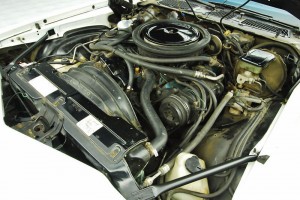WHY YOUR A/C COMPRESSOR IS LEAKING OIL OR REFRIGERANT
- Share
- publisher
- HELEN
- Issue Time
- May 13,2020
Summary
WHY YOUR A/C COMPRESSOR IS LEAKING OIL OR REFRIGERANT

Many people ask what maintenance steps they should take for their classic’s factory a/c system. Our tech guys always give the same, straight forward advice: “USE your air conditioning!” Contrary to popular belief, refrigerant is not consumed by using the air conditioning.
The most common source of lost refrigerant or oil in a functioning, leak-free system is at the compressor shaft seal. This is typically the result of cars and trucks that aren’t driven on a daily basis and/or experience sporadic use. Shaft seal leaks have been known to develop with periods of inactivity as short as two weeks. The common result is partial refrigerant loss and/or shaft seal oil leaks.
 It’s fairly common for someone to install a rebuilt or even new factory style compressor, (A5, A6, R4, RV2, York, Tecumseh, etc.) only to find that the compressor shaft seal is leaking refrigerant or oil. A little-known fact about A/C compressors is that the shaft seal is kept lubricated the entire time the compressor is engaged and running.
It’s fairly common for someone to install a rebuilt or even new factory style compressor, (A5, A6, R4, RV2, York, Tecumseh, etc.) only to find that the compressor shaft seal is leaking refrigerant or oil. A little-known fact about A/C compressors is that the shaft seal is kept lubricated the entire time the compressor is engaged and running.
Many factory a/c systems lose their charge when the a/c system is not being used. This happens as an under-lubricated seal around the compressor’s crankshaft dries up and develops a leak that allows for refrigerant and/or oil to escape. This wasn’t so much of a problem years ago, when you could bring your car to any service station and get R12 topped off for 99 cents; but those days are gone like the old Freon.
Below are some symptoms often seen in systems that are slightly undercharged. These conditions can indicate a loss of refrigerant as a result of your car’s air conditioning sitting dormant. (Please note: this is not an exhaustive list and your classic car may exhibit some or all of the symptoms below.)
- Clutch quickly cycles on/off (Not related to Suction valve system such as General Motors POA, HGV or STV systems, Ford POA systems or Mopar EPR systems.)
- Slightly low suction & discharge (low & high) pressure.
- Cool, not cold air at the vents. (Result of cold, but not frigid evaporator temp.)
- If you are using R12 refrigerant in your ac compressor, bubbles in the sight-glass ** TIP – the sight-glass will never be clear on a 134a system.
- Oil splashing the under-side of the hood after slinging from the area of the clutch. While this symptom can also indicate other problems, (contaminants in the system, bad shaft seal, high head pressures) it can be the result of oil leaking from the shaft seal as it dries up from not being used and gathering around the clutch & pulley until being used.
Air conditioning systems that are drastically undercharged may likewise exhibit some of the symptoms below:
- Compressor clutch doesn’t engage (If system equipped with a low-pressure switch.)
- Very low suction pressure. (System not in a vacuum.)
- Very low discharge pressure.
- Warm air at the vents.
- If you are using R12 refrigerant in your ac compressor, bubbles in the sight-glass ** TIP – the sight-glass will never be clear on a 134a system.
- Oil splashing the under-side of the hood after slinging from the area of the clutch. While this symptom can also indicate other problems, (contaminants in the system, bad shaft seal, high head pressures) it can be the result of oil leaking from the shaft seal as it dries up from not being used and gathering around the clutch & pulley until being used.
If your car is not used often and/or is stored for much of its life, simply start the car and run your air conditioning (with the compressor engaged) for approximately 30 seconds. Doing this every couple weeks or so keeps the compressor shaft-seal lubricated, which can prevent most shaft seal failures. If you are unable to run do this, fear not. In most cases, the shaft seal will re-seal itself once you start using the air conditioning again, though your system might require “topping off” of refrigerant and/or a good wiping down of the under-hood compartment until any oil clears the pulley assembly.